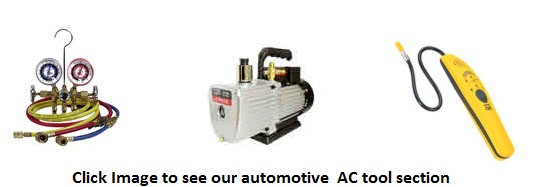What’s the Best Refrigerant Leak Detector? No false alarms.
June 29, 2014 Air Conditioning 2 Comments DenLorsTools.com Summary: So what’s the best refrigerant leak detector to use when looking for leaks on car air conditioning systems? I’ll answer that but first a little quick history. I originally used a propane leak detector when I started working on air conditioning on cars back at Goodyear in the 1980’s. The old propane leak detectors were very dependable. No false alarms. When Freon burns the flame turns a green and with very large leaks it turns into a bright purple. Problem is with burning Freon, toxic fumes are produced. It’s called Phosgene Gas. Very poisonous. I learned quickly that you don’t want to get a whiff of that. Obviously the propane leak detector was discontinued because of obvious reasons. As a side note. Refrigerant sucked up from the cars intake can burn in the engine and spew out Phosgene also. Once while working in an enclosed shop at CarMax, a tech working next to me had a huge Freon leak while the car was running. The Freon was immediately burned and spit out the exhaust. Not a pleasant thing to be around. Anyway, the point is; if you ever have a large refrigerant leak while working on a vehicle, make sure the engine is off until the area can be ventilated.
DenLorsTools.com Summary: So what’s the best refrigerant leak detector to use when looking for leaks on car air conditioning systems? I’ll answer that but first a little quick history. I originally used a propane leak detector when I started working on air conditioning on cars back at Goodyear in the 1980’s. The old propane leak detectors were very dependable. No false alarms. When Freon burns the flame turns a green and with very large leaks it turns into a bright purple. Problem is with burning Freon, toxic fumes are produced. It’s called Phosgene Gas. Very poisonous. I learned quickly that you don’t want to get a whiff of that. Obviously the propane leak detector was discontinued because of obvious reasons. As a side note. Refrigerant sucked up from the cars intake can burn in the engine and spew out Phosgene also. Once while working in an enclosed shop at CarMax, a tech working next to me had a huge Freon leak while the car was running. The Freon was immediately burned and spit out the exhaust. Not a pleasant thing to be around. Anyway, the point is; if you ever have a large refrigerant leak while working on a vehicle, make sure the engine is off until the area can be ventilated.
Refrigerant Leak Detectors
Refrigerant leak detectors need at least 50 psi of Freon in a system to be able to work. After-all they detect Freon and if there’s not enough in a system to leak out, how could it work? And check the system with a good electronic leak detector. I recommend that you don’t trust a leak detector every time it beeps, even with a good one. I’ve used leak detectors that would go off when sniffing an oak leaf, anti-freeze from the engine’s cooling system and even my breath! The best electronic leak detector that I’ve ever used was a Yokogawa/Bacharach. They are not cheap, but anyone doing a lot of AC work knows how expensive and time consuming it can be to misdiagnose leaks. So it’s important to have the best one you can afford. I first learned about the Yokogawa brand years ago (while working at CarMax) when I read a TSB (Technical Service Bulletin) from Nissan which named it as their only authorized leak detector for their warranty work. That’s when I purchased one. I paid way too much to the Snap On guy that had to special order it. He probably doubled his money on me. That’s a common practice for tool truck guys… That was way before I considered selling tools myself. No false alarms ever with my Yokogawa. We sell other brands but if anyone ever asks I always recommend the Yokogawa (also known as Bacharach).
 World’s Best Freon Leak Detector
So the Yokogawa leak detector that I purchased looked a little like an electronic device used in NASA from the 60’s or 70’s. It was made with metal and was stored in a vinyl case; an almost leather looking pouch. They look basically the same today. It plugged into an electrical outlet instead of running on batteries. While this makes it a little less convenient to use, it helps it to be more dependable because the power supply is constant. It also had to warm up before using it. But the greatest thing about it was- it never gave me a false alarm. If it alarmed, there was a leak. That’s saying a lot. It also works on all types of refrigerant including R12 and 134A. The TIF models that I had used prior to this always gave plenty of false alarms. The TIF and other battery operated leak detectors that I used, also tended to be even less dependable as the batteries faded. So in my book, the best leak detector in the world is the H10 Yokogawa. See the AC Leak Detection Tools section.






